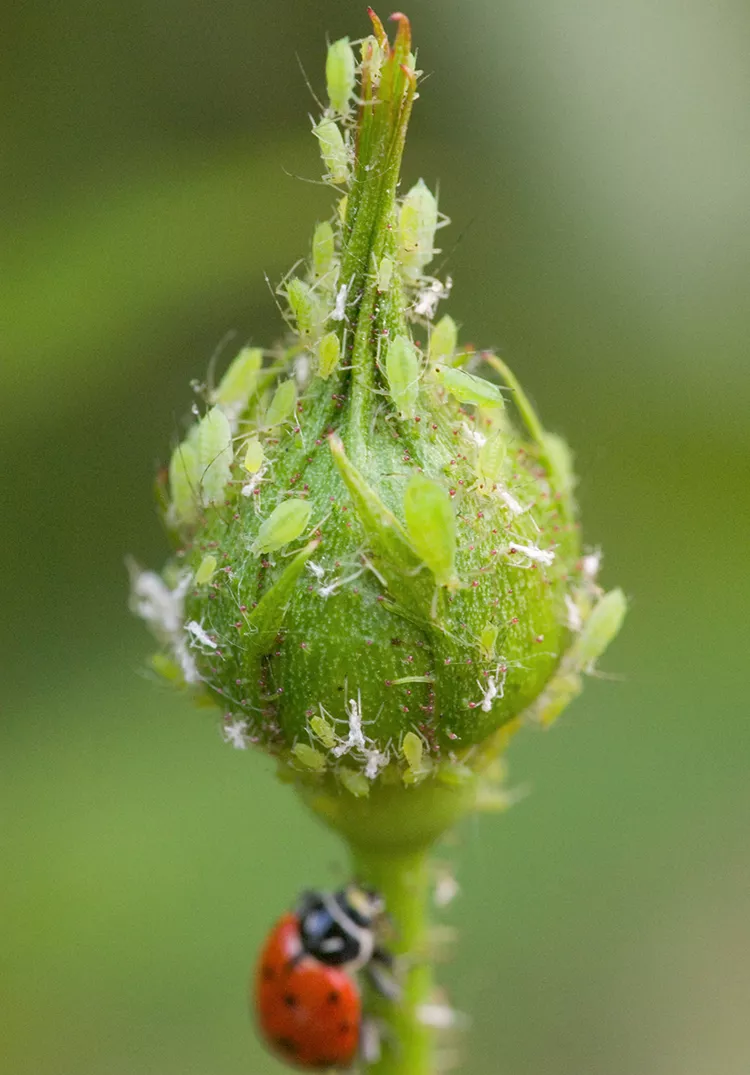Did you know that most gardens host at least a few aphids? These common insects don't cause much harm to healthy plants, and beneficial insects, including ladybugs, help reduce their numbers. However, aphids become more of a problem when things get out of whack, which can happen when drought, poor soil conditions, or overcrowding stress plants. You need to know how to get rid of aphids if this happens.
When garden conditions are just right, aphids can reproduce at an amazing speed in just a few days, creating a huge, hungry colony that can literally suck the life out of your plants. The key to dealing with these small but destructive pests is knowing when to take action and then having the right tricks up your sleeve to keep them under control.
How to Identify Aphids
Often the first sign of an aphid infestation is not the visible presence of the insects themselves. Instead, you'll see the symptoms of their feeding—twisted and curled leaves, yellowing foliage, stunted or dead shoots, and sluggish plant growth. Damage is usually most noticeable on shoot tips, new growth, and unopened flower buds. When you look closer at these damaged plant parts, particularly on the undersides of young leaves and developing stems, you'll likely find many aphids crowded together.
These insects range in color from green to yellow, brown, red, or even black. Aphids cause damage by sucking sap from tender plant parts. As they feast, they excrete a sugary substance called honeydew. A fungus called sooty mold grows on the honeydew and prevents light from reaching the plant but is otherwise harmless. You can wash your plant leaves with water to remove the honeydew and sooty mold.
How to Get Rid of Aphids
When an aphid population explodes and begins to cause noticeable damage to leaves, stems, and buds, it's time to act immediately. The sooner you can deal with the infestation, the better chance you have of stopping the pests in their tracks and saving your plants from the point of no return.
Spray with Water
The safest and fastest method for how to get rid of aphids is to spray them off your plants with a strong stream of water from the garden hose. Aphids are such small, soft-bodied insects that even a good rainstorm can knock them off. Once aphids are knocked off a plant, they rarely climb back on.
Insecticidal Soaps and Horticultural Oil
These controls are the least likely to cause damage to the environment or people. However, you still need to follow the label instructions for how to get rid of aphids. Insecticidal soaps and horticultural oil will kill aphids but must be applied regularly during heavy infestations since aphids reproduce so quickly. These products only kill aphids when they come in direct contact, so you'll need to reapply frequently until the pests are completely gone. And don't forget to spray the undersides of the leaves as well as the top.
Crush Aphids With Your Fingers
If you aren't the squeamish sort, and the infestation isn't so heavy that it would take forever to clean off, a non-toxic process of how to get rid of aphids is to gently rub your thumb and fingertips over your plants' leaves and stems wherever you see them. These insects are very soft and delicate, so they're crushed with light pressure. This tactic probably won't eliminate every bug, but it can help enough so that your plants can grow healthy leaves again. Check back every few days to see if you need to repeat the procedure.
How to Prevent Aphids
Preventing large numbers of aphids from making themselves at home is possible. In addition to ensuring your plants have the water, light, and necessary nutrients to stay healthy, here are a few more ways to help keep aphid numbers down.
Scout for Aphids Regularly
Make a habit of checking your plants every other day or so for any sign of aphids. That way, you'll catch the problem before it can get out of hand and become much harder to remedy.
Use Row Covers in Your Vegetable Garden
Protect young plants in your vegetable plot in spring with floating row covers. These will keep aphids (and many other insect pests) out but allow air, light, and moisture to reach your plants. Remove the row covers when your seedlings are several inches tall or when temperatures heat up in summer.
Remove Weeds
You may be watching for aphids on your plants, but these insects can also get a foothold in your garden by infesting weeds. Then it's only a matter of time before they spread to your vegetables and flowers, so be diligent and keep up with weeding around your plants. Some weeds, such as sow thistle and mustard, appear to be especially attractive to aphids.
Attract Beneficial Insects That Eat Aphids
Plant flowers, including marigolds, calendula, sunflower, daisy, alyssum, or dill nearby to attract beneficial insects that love to feed on aphids. Ladybugs and lacewings are especially effective at devouring them.




















